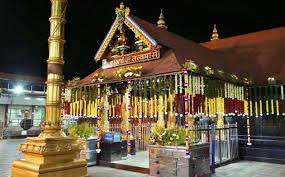The Essence of Observing Mandala Vratham
In the Indian yogic system, it has been adviced that any form of practice or sadhana be done for one Mandala i.e 48 days, because it is the length of time that is needed for the practice to take root in your system. Just as the embryo needs to spend enough time in the womb to become a fully formed child, a yogic practice needs its time to mature within our system. It takes some time for our food to digest and give us energy. Similarly, it will take some time for the practices to integrate with our system and offer us benefits.
While adopting yogic practices newly, we create a space in our mind for it. We also make the necessary adjustments in our environment to accommodate the new habit, say an adjustment in our time schedule. It takes time for the mind and body to be tuned to this. Hence don’t be quick to judge, keep practicing for a Mandala and then beyond.Forty-eight days or a mandala, a time period when the system goes through a certain cycle. This is also the reason why in Ayurveda for example, medicine is usually given for 48 days.
When we say "Sadhana" or any spiritual practice, we are talking about using every aspect of life – both internal and external – so that it is a continuous nurturing for your life. Because the very nature of a human being is such, unless there is some dynamism, some movement in his life towards betterment within and outside of himself, he will feel frustrated. He has to keep moving to a newer and newer possibility. Sadhana is an act which facilitates that. Everything can be sadhana. The way you eat, the way you sit, the way you stand, the way you breathe, the way you conduct your body, mind and your energies and emotions – this is sadhana. Sadhana does not mean any specific kind of activity, sadhana means you are using everything as a tool for your wellbeing.
The Mandala vratam is designed to cleanse and enhance the physical, mental and spiritual realms of the aspirant. In order to achieve this, the vratam directs the aspirant to adopt an austere life – getting up early every day, taking a bath in cold water, praying to the Lord, doing mantra chants and bhajans,focusing on good aspects of life, maintaining Trikarana shuddhi (purity in thoughts, words and deeds) every wakeful moment, bathing and worshipping in the evenings, participating in satsangs with other devotees, adopting a monastic dress code, not wearing footwear, eating and drinking simple satvik food in moderation that are spiritually enhancing etc.
The essence of practicing a sadhana or a mandala vratham is that one becomes more receptive to the Divine Grace or tto the tremendous possibilities of inner transformation.
Sabarimala Mandala Vratham:
November 16, 2016 marks the beginning of the Sabarimala Mandalam season this year - the transit of Sun into Scorpio – called vrischika sankramanam – and is the first day of kartikai. To millions of devotees of Lord ayyappan around the world, the day marks the start of the Mandala vratam, a six week period of austerities which will culminate in their pilgrimage to see the Lord in His abode on the Western Ghats (Shabari malai) and submit their iru-mudi at His feet. Most devotees are familiar with the vratam and its significance; every Guru swami will have expounded on this prior to the start of the vratam by the formal wearing of the mudra mala.
That also means, we do not just do vratam, we assiduously practice it – the samskrit word ‘Anushtanam’ (implying strict, well-thought out and regular practice) is normally used to describe it. It is not appropriate to take the vratam as a casual, do what you can activity – it is a regimen that requires commitment. Proper vratams have rules, not just guidelines. In addition, this vratam is guided by our preceptor, the guru , who initiated us in this vratam by gracing us with the mudra mala.Your body, your mind and your emotions have to be disciplined to channel your energies to the right direction.
Such an observance is an eight-step process, called 'Ashtanga yoga'. These progressive steps are: Yama (control), Niyama (discipline, following established procedures), Asana (proper posture), Pranayama (regulated breathing), Pratyahara (regulated consumption), Dharana (forbearance), Dhyana (meditation, contemplation), and samadhi (stilled senses, thoughts, in complete repose). In its ideal state, our vratam is to get us to 'yo mam pashyati sarvatra, sarvam cha mayi pashyati - one who sees Me everywhere, and sees everything as Mine' that state of devotion that Lord Krishna mentions in the Geeta. This is why we say 'Swami sharanam' to every one, and begin/finish all transactions with this phrase.
The guidelines for a devotee wishing to observe Sabarimala Mandala Vratha:
do's:
Maladharanam:- For SABARIMALA YATRA, the prime exercise is Maladharanam or rosary wearing. The Mala can be of either Rudraksham or Tulasi. The Mala should be worn through Guruswamy with whom the Bhaktha is intend to perform the Yatra. If Guruswamy could not be contacted or unavailable, the wearing of the Mala can be had through his mother or father or at any temple .
Mandala Vratham:- As a main principle, Mala should be worn first and then the vratham starts which should be observed for a minimum of 41 days and to be completed before the commencement of the Yatra.
Nitya Pooja :- From the day of Maladharanam and commencement of Vratham, the Bhaktas should take bath twice every day, i.e., early in the morning and after Sun set and to do small pooja at both the times. Also should chant Ayyappa Swami Saranams before the end of the daily Pooja.
Brahmacharyyam:- Should be observed very strictly during the entire 41 days of Vratham and continue till the end of Dharsanam, Abishekam at Sabarimala & mala visarjanam.
Mita Aharam:-During the Vratham period, Bakthas should take only moderate quantity of food as required to subside the hunger.
Mita Bhasha & Satya vaakku:-During this period always speak TRUTH and Talk LESS.
Karye Daivam:-What ever may be your daily work, you have to do for your livelihood, do it with full devotion on the Supreme Lord and discharge it in the correct manner.
Sarva Prani Samanatvam:- Treat all living creatures with love, as they are also created by the GOD, like us.
Taraka Mantram:-While talking with others (whether they are Ayyappa Swamis or not) the main Taraka Manthram, i.e. "Swami Sharanam "should be uttered with every sentence you use.
Swami Samuham:- As far as possible try to be in the company of small Ayyappa group so that you will not be deviated and also can gain more knowledge about the Divine creator, Punya Yatra or pilgrimage and Vratham.
Swami Bhajana:-During this period, as far possible, try to take part in the Poojas and Bhajans.
Annadanam:-Before the date of commencement of Yatra, within your capacity, if possible, do a small Pooja and do a small scale ANNADANAM to poor and needy people. The guidance in all the connected books clearly says that Ayyappas should do ANNADANAM to poor.
Nigraham:- Try always to be calm and even when you are being provoked by others, control your temper and say the only word “ SARANAM AYYAPPA”
Maligapuram & Manikanta:- Address all men as “Ayyappa or Swami” (Not only Vratham Ayyappas) and ladies and girls, including your wife as “MALIGAPURAM” and boys as “Manikanta”.
Sarvamata Samanatvam:-The main principle of Ayyappa Deeksha is, that all religions and castes are to be treated as ONE. Any body (Whether they are Christians, Muslims or other religion) having faith in Ayyappa, can worship Him. Ladies can participate in Poojas and Bhajans, but only girls below 10 years who have not attained Maturity and Ladies who have reached menopause, after certain age, can very well perform the Yatra duly observing the Vratham.
Manasa-Vaacha-Karma:-Manasa, Vaacha and Karmana (with mind, word and duty) have full devotion to Lord.
Vastradharanam:- Though there is no prescribed dress to wear during this Vratham and Yatra period, to distinguish you as Ayyappa on Deeksha either black, blue or saffron dresses can be worn.







ഹരിവരാസനം കീർത്തനത്തിന്റെ അർത്ഥം ....
ReplyDeleteഹരിവരാസനം
വിശ്വമോഹനം
ഹരിദധീശ്വരം
ആരാധ്യപാദുകം
അരിവിമർദ്ദനം
നിത്യ നർത്തനം
ഹരിഹരാത്മജം
ദേവമാശ്രയേ....
�� ഹരിയുടെ അനുഗ്രഹങ്ങൾക്ക് നിലയവും, വിശ്വത്തെമുഴുവൻ ആകർഷിക്കുന്നവനും,
സകല ദിക്കുകളുടേയും ഈശ്വരനും, ആരാദ്ധ്യങ്ങളായ പാദുകങ്ങളോട് കൂടിയവനും,
ശത്രുക്കളെ വിമർദ്ദനം ചെയ്തവനും, നിത്യവും നർത്തനം ചെയ്യുന്നവനും,
ഹരി(വിഷ്ണു) യുടെയും ഹരന്റെയും(ശിവൻ) പുത്രനുമായ ദേവാ....
അയ്യപ്പാ നിന്നിൽ ഞാൻ ശരണം തേടുന്നു....
��
ശരണ കീർത്തനം
ശക്ത മാനസം
ഭരണലോലുപം
നർത്തനാലസം
അരുണ ഭാസുരം
ഭൂതനായകം
ഹരിഹരാത്മജം
ദേവമാശ്രയേ...
�� ശരണകീർത്തനം ചെയ്യുന്ന ശക്ത മാനത്തൊടു കൂടിയവനും,
വിശ്വത്തിന്റെ പാലനത്തിൽ സന്തോഷമുള്ളവനും, നൃത്തം ചെയ്യാൻ തൽപ്പരനും ഉദയ സൂര്യനെപ്പോലെ പ്രശോഭിക്കുന്നവനും, സകല ഭൂതങ്ങളുടെയും നാഥനും,
ഹരിയുടേയും ഹരന്റെയും പുത്രനുമായ ദേവാ നിന്നെ ആശ്രയിക്കുന്നു....
അയ്യപ്പാ നിന്നിൽ ഞാൻ ശരണം തേടുന്നു....
��
പ്രണയ സത്യകം
പ്രാണ നായകം
പ്രണതകല്പകം
സുപ്രഭാഞ്ചിതം
പ്രണവ മന്ദിരം
കീർത്തന പ്രിയം
ഹരിഹരാത്മജം
ദേവമാശ്രയേ....
�� പ്രഭാസത്യക സമേതനും, മൂന്നാം പാദം പ്രാണനായകനും,
ഭക്തർക്ക് കൽപ്പതരു ആയവനും, ദിവ്യമായ പ്രഭയുള്ളവനും,
'ഓം'കാരമായ പ്രണവത്തിന്റെ ക്ഷേത്രം ആയവനും, കീർത്തനങ്ങളിൽ പ്രീതിയുള്ളവനും,
ഹരിഹര പുത്രനുമായ ദേവാ നിന്നെ ആശ്രയിക്കുന്നു...
അയ്യപ്പാ നിന്നിൽ ഞാൻ ശരണം തേടുന്നു...
��
തുരഗവാഹനം
സുന്ദരാനനം
വരഗദായുധം
വേദവർണ്ണിതം
ഗുരുകൃപാകരം
കീർത്തന പ്രിയം
ഹരിഹരാത്മജം
ദേവമാശ്രയേ.....
�� കുതിരയെ വാഹനമാക്കിയവനും, സുന്ദരമായ മുഖം ഉള്ളവനും,
ദിവ്യമായ ഗദ ആയുധമായുള്ളവനും, വേദത്താൽ വർണ്ണിക്കപ്പെടുന്നവനും,
ഗുരുവേപ്പോലെ കൃപചൊരിയുന്നവനും, കീർത്തനങ്ങളിൽ പ്രീതിയുള്ളവനും,
ഹരിഹരപുത്രനുമായ ദേവാ നിന്നെ ആശ്രയിക്കുന്നു.
അയ്യപ്പാ നിന്നിൽ ഞാൻ ശരണം തേടുന്നു.....
��
ത്രിഭുവനാർച്ചിതം
ദേവതാത്മകം
ത്രിനയനം പ്രഭും
ദിവ്യദേശികം
ത്രിദശ പൂജിതം
ചിന്തിത പ്രദം
ഹരിഹരാത്മജം
ദേവമാശ്രയേ....
�� മൂന്നു ലോകങ്ങളാലും പൂജിക്കപ്പെടുന്നവനും, ദേവന്മാരുടെയും ആത്മാവായ് വിളങ്ങുന്നവനും,
മുക്കണ്ണനായ സാക്ഷാൽ ശിവൻ തന്നെയായവനും, ദിവ്യനായ ഗുരുവും,
ഭൂതം, ഭാവി, വർത്തമാനം എന്നീ മൂന്നു കാലങ്ങളിലും പൂജിക്കപ്പെടുന്നവനും, ചിന്തിക്കുന്നതു മുഴുവൻ സത്യമാക്കുന്നവനും,
ഹരിഹരപുത്രനുമായ ദേവാ നിന്നെ ആശ്രയിക്കുന്നു.
അയ്യപ്പാ നിന്നിൽ ഞാൻ ശരണം തേടുന്നു....
��
ഭവഭയാപഹം
ഭാവുകാവഹം
ഭുവനമോഹനം
ഭൂതിഭൂഷണം
ധവളവാഹനം
ദിവ്യവാരണം
ഹരിഹരാത്മജം
ദേവമാശ്രയേ.....
�� ഭവഭയത്തെ അകറ്റുന്നവനും, ഐശ്വര്യദായകനും
ഭുവനത്തെ മുഴുവൻ ആകർഷിക്കുന്നവനും, ഭസ്മ വിഭൂഷിതനും,
വെളുത്ത നിറമുള്ള ദിവ്യമായ ആനയെ വാഹനമാക്കിയവനും,
ഹരിഹരപുത്രനുമായ ദേവാ നിന്നെ ആശ്രയിക്കുന്നു.
അയ്യപ്പാ നിന്നിൽ ഞാൻ ശരണം തേടുന്നു...
��
കള മൃദുസ്മിതം
സുന്ദരാനനം
കളഭ കോമളം
ഗാത്ര മോഹനം
കളഭ കേസരി
വാജിവാഹനം
ഹരിഹരാത്മജം
ദേവമാശ്രയേ....
�� മന്ദസ്മേര യുക്തമായ സുന്ദര മുഖമുള്ളവനും,
കളഭം അണിഞ്ഞ മനോഹര ശരീരമുള്ളവനും,
ആന,പുലി, കുതിര എന്നിവയെ വാഹനമാക്കിയവനും,
ഹരിഹരപുത്രനുമായ ദേവാ നിന്നെ ആശ്രയിക്കുന്നു.
അയ്യപ്പാ നിന്നിൽ ഞാൻ ശരണം തേടുന്നു...
��
ശ്രിതജനപ്രിയം
ചിന്തിതപ്രദം
ശ്രുതിവിഭൂഷണം
സാധുജീവനം
ശ്രുതിമനോഹരം
ഗീതലാലസം
ഹരിഹരാത്മജം
ദേവമാശ്രയേ....
��ഭക്തന്മാർക്ക് പ്രിയപ്പെട്ടവനും, ചിന്തിക്കുന്നതു മുഴുവൻ സത്യമാക്കുന്നവനും,
യാതൊരുവനാണോ വേദങ്ങൾ ആഭരണമായത് , സുകൃതികളുടെ ജീവനായിട്ടുള്ളവനും,
മനോഹരമായ ശ്രുതിയോടു കൂടിയവനും, ഗീതത്തിൽ ലസിച്ചിരിക്കുന്നവനും ആയ അയ്യപ്പാ നിന്നിൽ ഞാൻ ശരണം തേടുന്നു...
*ശരണമയ്യപ്പാ സ്വാമി ശരണമയ്യപ്പാ...
*ശരണമയ്യപ്പാ സ്വാമി ശരണമയ്യപ്പാ...
*ശരണമയ്യപ്പാ സ്വാമി ശരണമയ്യപ്പാ...
*ശരണമയ്യപ്പാ സ്വാമി ശരണമയ്യപ്പാ...
101 ശരണം വിളികള് (101 Saranam Vilikal)
ReplyDelete1. സ്വാമിയേ ശരണമയ്യപ്പ
2. ഹരിഹര സുതനേ ശരണമയ്യപ്പ
3. കന്നിമൂലഗണപതി ഭഗവാനേ ശരണമയ്യപ്പ
4. അച്ചന്കോവില് അരശേ ശരണമയ്യപ്പ
5. ആരിയന്കാവയ്യനേ ശരണമയ്യപ്പ
6. കുത്തൂപ്പുഴബാലകനേ ശരണമയ്യപ്പ
7. അയ്യം തീര്പ്പവനേ ശരണമയ്യപ്പ
8. ആപത് ബാന്ധവനേ ശരണമയ്യപ്പ
9. അനാഥരക്ഷകനേ ശരണമയ്യപ്പ
10. എന്കും നിറൈന്തവനേ ശരണമയ്യപ്പ
11. ഏഴൈപന്കാളനേ ശരണമയ്യപ്പ
12. എന്കള് കുലദൈവമേ ശരണമയ്യപ്പ
13. ഏകാന്ത വാസനേ ശരണമയ്യപ്പ
14. എരുമേലി ശാസ്താവേ ശരണമയ്യപ്പ
15. ഐംകരന് തമ്പിയേ ശരണമയ്യപ്പ
16. അമൈതിയൈ അളിപ്പവനേ ശരണമയ്യപ്പ
17. അണിയും തുളസി മണിയേ ശരണമയ്യപ്പ
18. അഭയം തരുവോനെ ശരണമയ്യപ്പ
19. അഴകുക്കോര് വടിവമേ ശരണമയ്യപ്പ
20. ആനന്ദരൂപനേ ശരണമയ്യപ്പ
21. യാനൈമുഖന്തമ്പിയേ ശരണമയ്യപ്പ
22. ഇരുമുടി പ്രിയനേ ശരണമയ്യപ്പ
23. ഈശനിന് പുത്തിരനേ ശരണമയ്യപ്പ
24. അറുപടയാന് തമ്പിയേ ശരണമയ്യപ്പ
25. ഒപ്പറ്റ്റ ദൈവമേ ശരനമയ്യപ്പ
26. ഓങ്കാര പരംപൊരുളേ ശരണമയ്യപ്പ
27. കലിയുഗ വരദനേ ശരണമയ്യപ്പ
28. കണ് കണ്ടദൈവമേ ശരണമയ്യപ്പ.
29. കാരുണ്ണ്യമൂര്ത്തിയേ ശരണമയ്യപ്പ
30. കര്പ്പൂര ജ്യോതിയേ ശരണമയ്യപ്പ
31. കാന്തമലൈജ്യോതിയേ ശരണമയ്യപ്പ
32. ഗുരുവുക്കും ഗുരുവേ ശരണമയ്യപ്പ
33. സകലകലാ വല്ലഭനേ ശരണമയ്യപ്പ
34. ശബരി ഗിരീശനേ ശരണമയ്യപ്പ
35. ശിവനരുള് ശെല്വനേ ശരണമയ്യപ്പ
36. തവക്കോലം കൊണ്ടവനേ ശരനമയ്യപ്പ
37. തിരുമാല് മകനേ ശരണമയ്യപ്പ
38. നീലകണ്ഠന് മകനേ ശരണമയ്യപ്പ
39. നൈ അഭിഷേകപ്രിയനേ ശരണമയ്യപ്പ
40. പാണ്ധ്യരാജന് കുലകൊഴുന്തേ ശരണമയ്യപ്പ
41. പാര്ത്ഥസാരഥി മകനേ ശരണമയ്യപ്പ
42. ഭൂതപ്പടൈ തലൈവനേ ശരണമയ്യപ്പ
43. മാധവന് മകനേ ശരണമയ്യപ്പ
44. മെയ്ഞാന മൂര്ത്തിയേ ശരണമയ്യപ്പ
45. ജാതി-മതം കലൈന്തവനേ ശരണമയ്യപ്പ
46. ഗുരുവായൂരപ്പ മൂര്ത്തിയേ ശരണമയ്യപ്പ
47. വൈക്കത്തപ്പ ദേവനേ ശരണമയ്യപ്പ
48. വതക്കുംനാഥ സ്വാമിയെ ശരണമയ്യപ്പ
49. ഏറ്റുമാനൂരപ്പനേ ശരണമയ്യപ്പ
50. കടുത്തിരുത്തി ദേവനേ ശരണമയ്യപ്പ
51. പാറമേല്ക്കവമ്മ ദേവിയെ ശരണമയ്യപ്പ
52. ചോറ്റാനിക്കരയമ്മ ദേവിയെ ശരണമയ്യപ്പ
53. മണപ്പുള്ളിക്കാവമ്മ ദേവിയെ ശരണമയ്യപ്പ
54. മീന്കുളത്തിയമ്മ ദേവിയേ ശരണമയ്യപ്പ
55. മധുര മീനാക്ഷിഅമ്മ ദേവിയേ ശരണമയ്യപ്പ
56. എറണാകുളത്തപ്പ ദേവനേ ശരണമയ്യപ്പ
57. മാളികപ്പുറത്തമ്മ ദേവിയേ ശരണമയ്യപ്പ
58. മോഹിനി സുതനേ ശരണമയ്യപ്പ
59. വലിയ കടുത്തസ്വാമിയേ ശരണമയ്യപ്പ
60. ചെറിയകടുത്തസ്വാമിയേ ശരണമയ്യപ്പ
61. വാവരിന് തോഴനേ ശരണമയ്യപ്പ
62. പംപാനദിയേ ശരണമയ്യപ്പ
63. പന്പാ വിളക്കേ ശരണമയ്യപ്പ
64. കരിമലൈ വാസനേ ശരണമയ്യപ്പ
65. അഴുതാ നദിയേ ശരണമയ്യപ്പ
66. കല്ലിടാം കുന്നേ ശരണമയ്യപ്പ
67. ചെറിയാന വട്ടമേ ശരണമയ്യപ്പ.
68. വലിയാനവട്ടമേ ശരണമയ്യപ്പ
69. അന്നദാനപ്രഭുവേ ശരണമയ്യപ്പ
70. ആനന്ദ ദായകനേ ശരണമയ്യപ്പ
71. വന് പുലി വാഹനനേ ശരണമയ്യപ്പ
72. വില്ലാളി വീരനേ ശരണമയ്യപ്പ
73. പായസാന്ന പ്രിയനേ ശരണമയ്യപ്പ
74. വീരമണി കണ്ഠനേ ശരണമയ്യപ്പ
75. ആശ്രിത വത്സലനേ ശരണമയ്യ
76. നൈ അഭിഷേകപ്രിയനേ ശരണമയ്യപ്പ
77. സേവിപ്പോര്ക്കഭയം തരുവോനെ ശരണമയ്യപ്പ.
78. ഭസ്മാഭിഷേക പ്രിയനേ ശരനമയ്യപ്പ
79. ശബരീപീഠമേ ശരണമയ്യപ്പ
80. അപ്പാച്ചി മേടേ ശരണമയ്യപ്പ
81. ഇപ്പാച്ചികുഴിയേ ശരണമയ്യപ്പ
82. ശരംകുത്തി ആലേ ശരണമയ്യപ്പ
83. ആശ്രിതവത്സലനേ ശരണമയ്യപ്പ
84. അഭയപ്രദായകനേ ശരണമയ്യപ്പ
85. പന്തളരാജകുമാരനേ ശരണമയ്യപ്പ
86. വല്ലീദേവയാന സമേത ശ്രീ സുബ്രഹ്മണ്യ സ്വാമിയേ ശ്രരണമയ്യപ്പ
87. ക്ഷുരികായുധനേ ശരണമയ്യപ്പ
88. വാവരിന് തോഴനേ ശരണമയ്യപ്പ
89. മഹിഷീസംഹാരനേ ശരണമയ്യപ്പ
90. ജാതിമതമില്ലാ ദൈവമേ ശരണമയ്യപ്പ
91. സേവിപ്പോര്ക്കാനന്ദ മൂര്ത്തിയേ ശരണമയ്യപ്പ
92. ശത്രു സംഹാരനേ ശരണമയ്യപ്പ
93. ഭഗവാനിന് പൊന്നു പതിനെട്ടു പടികളെ ശരണമയ്യപ്പ.
94. ഭഗവാനിന് തിരുസന്നിധിയേ ശരണമയ്യപ്പ
95. ഭസ്മക്കുളമേ ശരണമയ്യപ്പ
96. ആജ്യാഭിഷേക പ്രിയനേ ശരണമയ്യപ്പ
97. പൊന്നംബല മേടേ ശരണമയ്യപ്പ
98. സമ്സതാപരാധം പൊറുത്തരുളേണമേ ശരണമയ്യപ്പ
99. വാവരില് തോഴനേ ശരണമയ്യപ്പ
100.അഖിലാണ്ഡ കോടി ബ്രഹ്മാണ്ഡ നായകനേ ശരണമയ്യപ്പ..
101.ഹരിഹരസുതനാനന്ദചിത്തനയ്യനയ്യ്പ് സ്വാമിയേ ശരണമയ്യപ്പ........